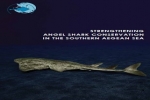Bioluminescence of the Largest Luminous Vertebrate, the Kitefin Shark
Bioluminescence of the Largest Luminous Vertebrate, the Kitefin Shark, Dalatias licha: First Insights and Comparative Aspects Jérôme Mallefet, Darren W. Stevens, Laurent Duchatelet ABSTRACT: Bioluminescence has often been seen as a spectacular yet uncommon event at sea but considering the vastness of the deep sea and the occurrence of luminous organisms in this zone, it
Description of the chondrocranium of the silky shark
Description of the chondrocranium of the silky shark Carcharhinus falciformis with comments on the cranial terminology and phylogenetic implications in carcharhinids (Chondrichthyes, Carcharhiniformes, Carcharhinidae) Fernanda de Oliveira Lana, Karla D. A. Soares. Fábio Hissa Vieira Hazin, Ulisses Leite Gomes ABSTRACT: The definition and scope of the genus Carcharhinus has undergone several changes over the years
Climate change shifts abiotic niche of temperate skates
Climate change shifts abiotic niche of temperate skates towards deeper zones in the Southwestern Atlantic Ocean Jéssica Fernanda Ramos Coelho, Sergio Maia Queiroz Lima, Flávia de Figueiredo Petean ABSTRACT: Climatic changes are disrupting distribution patterns of populations through shifts in species abiotic niches and habitat loss. The abiotic niche of marine benthic taxa such as
Strengthening Angel Shark Conservation in the Southern Aegean Sea
Giovos, I., Katsada, D., Naasan Aga Spyridopoulou, R., Doxa, A., Katsanevakis, S., Sini, M., Oikonomou, V., Poursanidis, D., Hood, A.R. Strengthening Angel Shark Conservation in the Southern Aegean Sea. iSea, Greece, 12pp, 2021 PDF-DOWNLOAD
Model Selection of Shark Attack Case
Size Does Matter: Model Selection of Shark Attack Case Andri Wibowo ABSTRACT: Shark unprovoked attacks consist of fatal and non-fatal cases. Numerous cases have been reported involving shark species from Carcharhinus melanopterus with length of 145.5 cm to half-ton Carcharodon carcharias. Currently there are more (P < 0.05) unprovoked non-fatal cases with the average is
Cartilaginous Fish of the Eastern Adriatic Sea
Cartilaginous Fish of the Eastern Adriatic Sea: A Review of the Records from the Past Decade (2010–2019) Ilija Ćetković, Tamara Mitrović, Stefan Ralević, Jovana Tomanić, Nikola Paskaš ABSTRACT: This review article is dedicated to the description and summarization of the chondrichthyans-related scientific research for the area of the Eastern Adriatic Sea. An online data inventory
Wound-healing capabilities of whale sharks
Wound-healing capabilities of whale sharks (Rhincodon typus) and implications for conservation management Freya Womersley, James Hancock, Cameron T Perry, David Rowat ABSTRACT: Wound healing is important for marine taxa such as elasmobranchs, which can incur a range of natural and anthropogenic wounds throughout their life history. There is evidence that this group shows a high
Shark depredation over catches in the Strait of Messina
When opportunistic predators interact with swordfish harpoon fishing activities: shark depredation over catches in the Strait of Messina (central Mediterranean Sea) D. Malara , P. Battaglia , P. Consoli , E. Arcadi , F. Longo , M. G. Stipa , L.Pagano , S. Greco , F. Andaloro, T. Romeo ABSTRACT: We describe the interaction between
Overfishing and habitat loss drive range contraction of iconic marine fishes to near extinction
Overfishing and habitat loss drive range contraction of iconic marine fishes to near extinction Helen F. Yan, Peter M. Kyne, Rima W. Jabado, Ruth H. Leeney, Lindsay N.K. Davidson, Danielle H. Derrick, Brittany Finucci, Robert P. Freckleton, Sonja V. Fordham, Nicholas K. Dulvy ABSTRACT: Extinctions on land are often inferred from sparse sightings over time,
North Pacific warming shifts the juvenile range of white sharks
North Pacific warming shifts the juvenile range of a marine apex predator Kisei R. Tanaka, Kyle S. Van Houtan, Eric Mailander, Beatriz S. Dias, Carol Galginaitis, John O’Sullivan, Christopher G. Lowe, Salvador J. Jorgensen ABSTRACT: During the 2014–2016 North Pacific marine heatwave, unprecedented sightings of juvenile white sharks (Carcharodon carcharias) emerged in central California. These
Quantifying the unreported and unaccounted domestic and foreign commercial catch of sharks and rays in Western Australia
Quantifying the unreported and unaccounted domestic and foreign commercial catch of sharks and rays in Western Australia Matias Braccini, Mervi Kangas, Vanessa Jaiteh, Stephen Newman ABSTRACT: Reliable catch information is scarce for most sharks and rays worldwide, with almost half of the stocks considered to be Data Deficient due to limited species-specific catch statistics. Western
Boosted regression tree models predict the diets of juvenile bull sharks
Boosted regression tree models predict the diets of juvenile bull sharks in a subtropical estuary Emy Cottrant, Philip Matich, Mark R. Fisher ABSTRACT: Understanding diet flexibility is important for resource management as climate change alters ecological communities. However, food web complexity often limits our ability to predict how changes in prey communities may alter predator
Using fisher‐contributed secondary fins to fill critical shark‐fisheries data gaps
Using fisher‐contributed secondary fins to fill critical shark‐fisheries data gaps Jessica R. Quinlan, Shannon J. O’Leary, Andrew T. Fields, Martin Benavides, Emily Stumpf, Ramon Carcamo, Joel Cruz, Derrick Lewis, Beverly Wade, George Amato, Sergios‐Orestis Kolokotronis, Gina M. Clementi, Demian D. Chapman ABSTRACT: Developing‐world shark fisheries are typically not assessed or actively managed for sustainability; one
Identifying nearshore nursery habitats for sharks in the Eastern Tropical Pacific
Identifying nearshore nursery habitats for sharks in the Eastern Tropical Pacific from fisheries landings and interviews Juliana López-Angarita, Melany Villate, Juan Manuel Díaz, Juan C. Cubillos, Alexander Tilley ABSTRACT: The Eastern Tropical Pacific (ETP) comprising the coasts of Costa Rica, Panama, Colombia and Ecuador, represents an area of high marine biodiversity that supports productive fisheries
Age and growth of tiger shark from Western Australia
Age and growth of tiger shark (Galeocerdo cuvier) from Western Australia Sophia M. Emmons, Brooke M. D’Alberto, Jonathan J. Smart, Colin A. Simpfendorfer ABSTRACT: The tiger shark (Galeocerdo cuvier) is believed to be a fast-growing shark that has shown regional variation in growth. Vertebrae samples were taken from 124 tiger sharks (60 females, 38 males,




